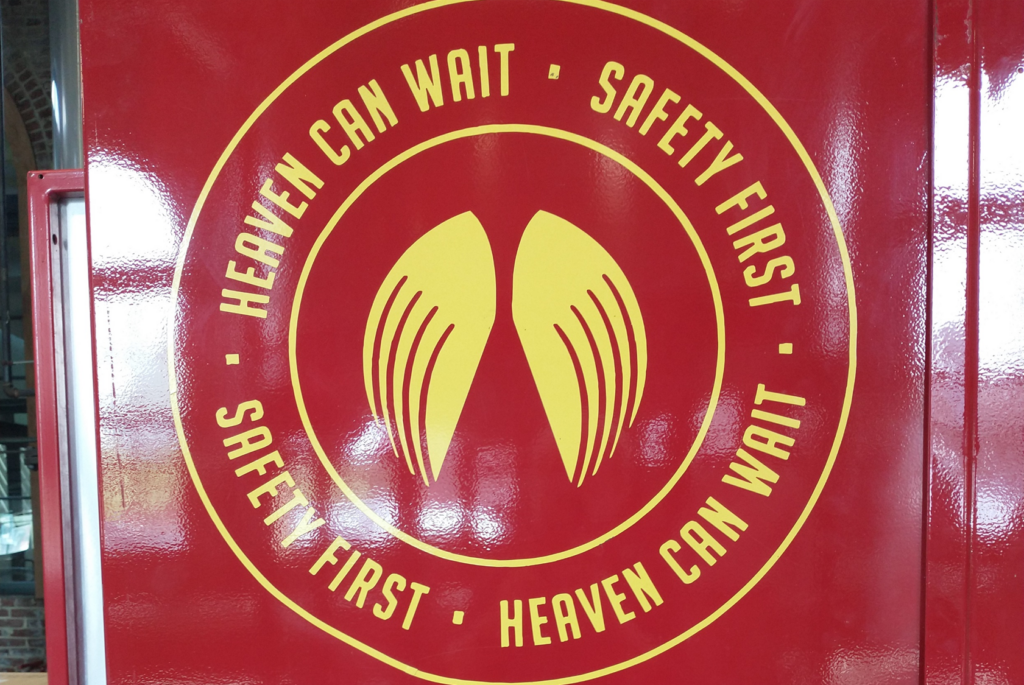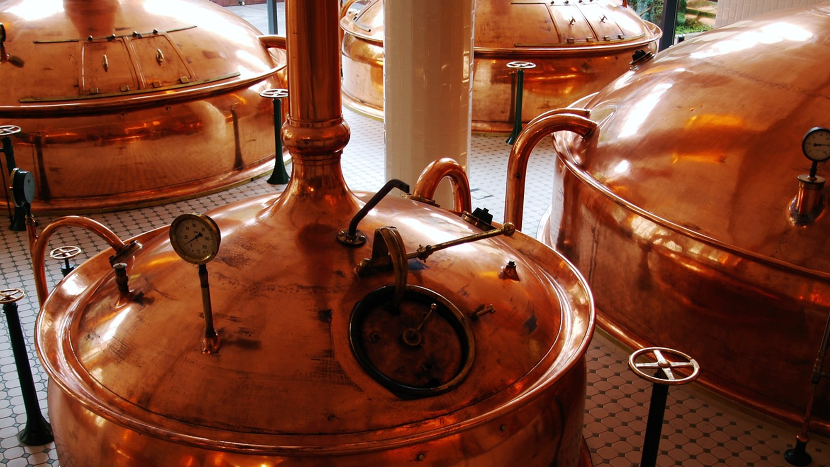“Devils drinking devils and the flames are getting higher. All of Bardstown’s crying tonight, Heaven Hill’s on fire.” — Shannon Lawson, The Galoots
Chris Schmidt and I recently returned from a week-long trip to Kentucky to enjoy the countryside and to sample bourbons from some of the 46 distilleries on the Kentucky Bourbon Trail. As fascinated as I was by the nuances of tasting bourbon — I have a much better appreciation for bourbon now – and by the subtleties of bourbon-making, I could not help but notice the process safety issues that distilleries, large and small, have to deal with.
I thought that readers of this blog would be as interested as I was.
Milling Grain For The Mash Creates A Combustible Dust
The mash bill for bourbons must have 51% or more of corn. Additionally, malted barley is essential for providing the enzymes that convert starches into simple sugars that yeast ferments to ethanol. Rye or wheat are also used in some combination to give each whiskey a distinctive flavor.
Before the grains are charged into the fermenters, the distiller must mill them into a grit similar to that of corn meal. Only one of the distilleries that we visited, a small craft distillery, took their tour groups to their milling area, which wasn’t in operation at the time. I saw some accumulation of dust but since it was not operating, I don’t know about dust clouds. There is a long history of grain dust explosions in the grain handling industry, and it should be a concern of distilleries.
Carbon Dioxide From Fermentation Is An Asphyxiant
Once the mash is in the fermenter, the amylase enzymes from the malted barley break the starch down into sugars and the yeast goes to work converting those sugars to ethanol. In the course of producing ethanol, the yeast also produces CO2:
C6H12O6 → 2 H3CH2COH + 2 CO2
That means that for every pound of ethanol produced, the yeast also produces 0.9565 pounds of CO2. Put another way, fermentation produces 27.5 standard cubic feet of CO2 per proof gallon. (A proof gallon is one gallon of 100 proof ethanol, 50% ABV).
On our tours, we learned that fermentation typically takes 3 to 6 days. It starts off slowly, but by the second day, the mash is bubbling furiously, throwing off serious volumes of CO2. The permissible exposure limit (PEL) for CO2, which is set by the Occupational Safety and Health Administration (OSHA), is 5,000 ppm (0.5% by volume in air). A higher concentration, the level that is Immediately Dangerous to Life and Health (IDLH) is set by the National Institute for Occupational Safety and Health (NIOSH). For CO2, the IDLH is 50,000 ppm (5% by volume in air).
Only one of the distilleries that we visited—Angel’s Envy—used closed fermenters with a vent stack through the roof. The fermenters that we saw in other distilleries were open top vessels, meaning that the CO2 vented directly into the fermentation room. While I doubt that the level of CO2 reached the IDLH except for right at the surface of the mash, I wouldn’t be surprised to learn that the CO2 level in the room exceeded the PEL, especially at those distilleries where ventilation wasn’t deliberately designed to address CO2 levels.
Whiskey Is A Toxic Material
On every distillery tour, we could smell the ethanol. Our tour guides proudly called it to our attention. As bourbon enthusiasts, the people on the tour enjoyed it. For workers in distilleries, however, there may be a concern about long term exposure.
OSHA’s PEL for ethanol is 1000 ppm, or 0.1% by volume in air. Keeping concentrations below the PEL protects workers against toxic exposures. Given an ethanol vapor pressure of 0.0587 atm at 20 C (68°F) and assuming that Raoult’s law holds, a solution higher than 5.32% ABV will generate an atmosphere above the OSHA PEL. At 25 C (77°F), the vapor pressure of ethanol increases to 0.0773 atm, which means that a solution of 4.08% ABV is enough to generate an atmosphere above the OSHA PEL.
The IDLH set by NIOSH for ethanol is 3300 ppm. NIOSH set it at that level because that is 10% of the Lower Explosive Limit (LEL) of ethanol. NIOSH is implicitly acknowledging that the process hazard of gravest concern for ethanol is its flammability and its resulting explosivity as a flammable substance.
Whiskey Is A Flammable Liquid
The explosive limits of ethanol, from LEL to UEL, are 3.3% to 19% by volume in air. The flash point of pure ethanol, 200 proof, is 55°F. That means that at 55°F, 200 proof alcohol will generate an ethanol vapor concentration of 3.3% in the air above it. As the proof decreases, the mixture must get warmer before it is able to form a flammable mixture with air. The table below shows relationship of flash point to alcohol proof.
Flash Point of Alcohol at Different Proofs
| Alcohol Concentration | Flash point |
| 10 proof (5% ABV) | 62 C (144°F) |
| 20 proof (10% ABV) | 49 C (120°F) |
| 35.5 proof (17.8% ABV) | 37.8 C (100°F) |
| 40 proof (20% ABV) | 36 C (97°F) |
| 60 proof (30% ABV) | 29 C (84°F) |
| 80 proof (40% ABV) | 26 C (79°F) |
| 100 proof (50% ABV) | 24 C (75°F) |
| 120 proof (60% ABV) | 22 C (72°F) |
| 140 proof (70% ABV) | 21 C (70°F) |
| 160 proof (80% ABV) | 20 C (68°F) |
| 180 proof (90% ABV) | 17 C (63°F) |
| 190 proof (95% ABV) | 15 C (59°F) |
| 200 proof (100% ABV) | 13 C (55°F) |
So, while the fermentation step does not create an NFPA Class I Flammable liquid with a flash point below 100°F, everything from distillation on does. With that comes all of the hazards associated with flammable liquids: hazardous (classified) locations, vapor cloud explosions (VCEs), etc.
Distilleries Use Closed Vessels
While all of the stills that we saw operated at atmospheric pressure, whether pot stills or column stills, the paths to atmosphere of each had the potential to be plugged with solids from the mash.
The overhead condensers were not old-style worms in old barrels overflowing with creek water, but shell-and-tube heat exchangers.
The proofing tanks, into which the distillate, aka “white dog”, “white lightning”, “moonshine”, and “new make”, collects were all closed vertical atmospheric tanks.
This means that not only did the distilleries have the material for a VCE, but they also had equipment that could be subject to pressure vessel explosions (PVEs). Unfortunately, I didn’t see pressure relief devices everywhere I expected to see them. For those that I did see, I found myself hoping that they were properly sized and maintained.
Whiskey Is A Pollutant
We visited distilleries in the country and in the city. One of the features at some of the distilleries located in the countryside were berms that surrounded their rickhouses, where they aged thousands of barrels of whiskey. Knowing that the bourbon industry has a history of rickhouse fires and collapses, I was pleased to see berms on those occasions when I did. On one tour, of the Lux Row Distillery in Bardstown, the tour guide made a point of mentioning their berm.
I imagine that the Kentucky Energy and Environment Cabinet is also pleased to see berms around rickhouses. During the past 25 years, there have been six major instances of rickhouse failures or fires. Five resulted in substantial whiskey releases to Kentucky’s waterways and significant fish kills. The one that didn’t was protected by its berm.
Are Whiskey Distilleries Covered by PSM?
The Process Safety Management (PSM) standard (29 CFR 1910.119) applies to processes that exceed the threshold quantity of certain toxic chemicals, or to processes that exceed 10,000 pounds of flammable liquids or gases. A process is defined as “any use, storage, manufacturing, handling, or the on-site movement of such chemicals”. A flammable liquid is any liquid with a flash point below 100°F, e.g., any ethanol-water mixture at higher than 35.5 proof.
The PSM standard has no exemption for beverage alcohol, but it does have an exemption for flammable liquids stored in atmospheric tanks, if they are kept below their normal boiling point without chilling or refrigeration. An atmospheric tank is one designed to operate between atmospheric pressure through 0.5 psig. OSHA considers drums, barrels, and bottles to be atmospheric storage tanks.
The atmospheric storage tank exception does not apply to any vessels which do more than store—stills, proofing tanks, blending tanks—even if operated at atmospheric pressure.
A Shout Out
Like other facilities throughout the chemical process industries, distilleries vary in how they deal with process safety, from doing what they have to do to get by in a highly competitive business to state-of-the-art process safety measures. I hope to see all distilleries work on continuous improvement to their process safety, driven by a desire to get better rather than in response to disasters at their facilities or others.

Photo credit: Chris Schmidt, Bluefield Process Safety, LLC, CC BY 4.0
The most important thing that any facility can do in regard to safety is to promote a deeply ingrained, company-wide safety culture. From what I was able to see on their public tour, the Angel’s Envy distillery in downtown Louisville deserves a special shout-out. The first thing we heard was a review of safety measures and instructions. Then, throughout their facility, I saw evidence of their safety program. They have incorporated their brand identity into their safety program and was impressed. I hope it has the same impact on the workers there.

I read your blog, it is amazing, thank you for providing us this information. We are also providing process safety testing services, you can check our websites.